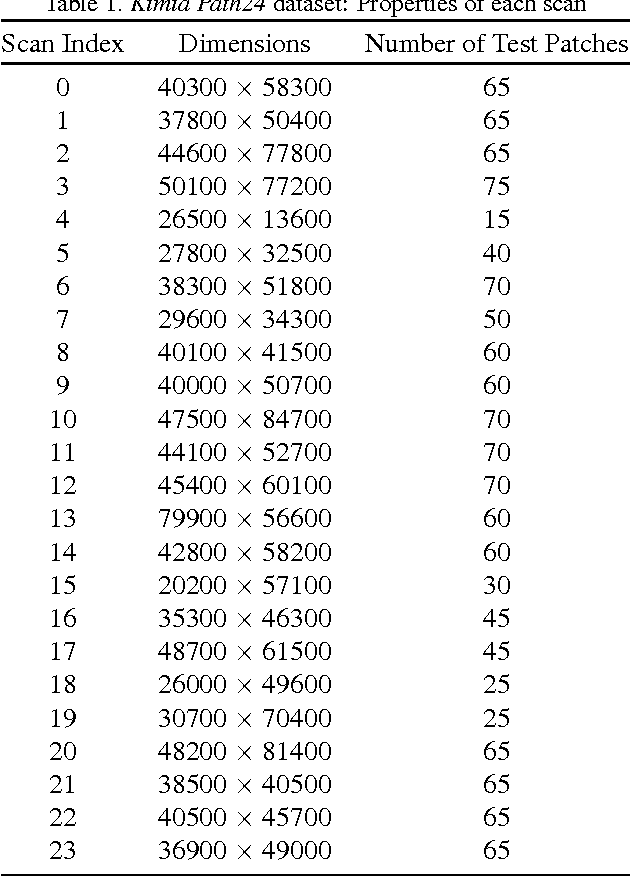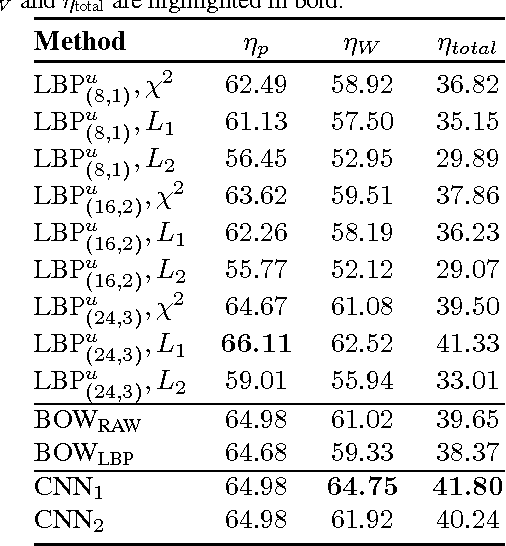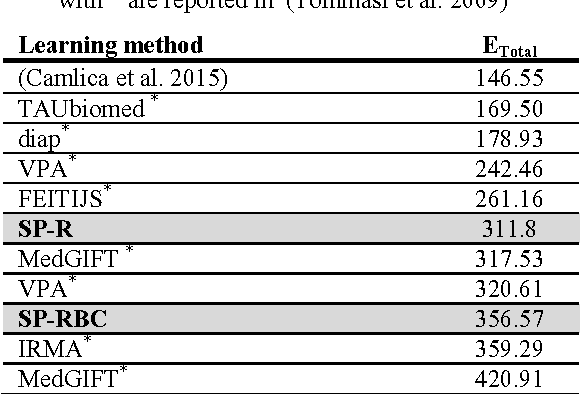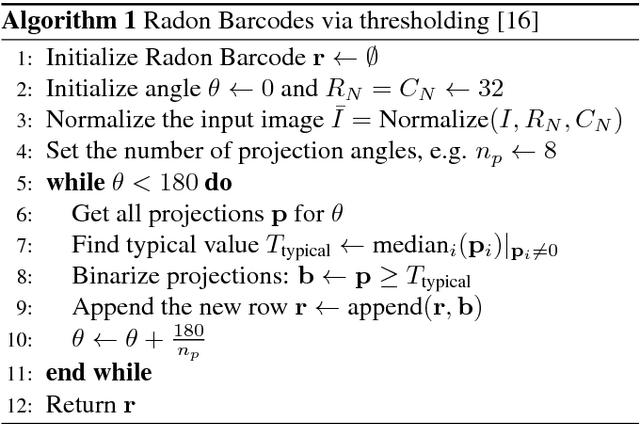Shujin Zhu
A Comparative Study of CNN, BoVW and LBP for Classification of Histopathological Images
Sep 27, 2017



Abstract:Despite the progress made in the field of medical imaging, it remains a large area of open research, especially due to the variety of imaging modalities and disease-specific characteristics. This paper is a comparative study describing the potential of using local binary patterns (LBP), deep features and the bag-of-visual words (BoVW) scheme for the classification of histopathological images. We introduce a new dataset, \emph{KIMIA Path960}, that contains 960 histopathology images belonging to 20 different classes (different tissue types). We make this dataset publicly available. The small size of the dataset and its inter- and intra-class variability makes it ideal for initial investigations when comparing image descriptors for search and classification in complex medical imaging cases like histopathology. We investigate deep features, LBP histograms and BoVW to classify the images via leave-one-out validation. The accuracy of image classification obtained using LBP was 90.62\% while the highest accuracy using deep features reached 94.72\%. The dictionary approach (BoVW) achieved 96.50\%. Deep solutions may be able to deliver higher accuracies but they need extensive training with a large number of (balanced) image datasets.
Classification and Retrieval of Digital Pathology Scans: A New Dataset
May 22, 2017



Abstract:In this paper, we introduce a new dataset, \textbf{Kimia Path24}, for image classification and retrieval in digital pathology. We use the whole scan images of 24 different tissue textures to generate 1,325 test patches of size 1000$\times$1000 (0.5mm$\times$0.5mm). Training data can be generated according to preferences of algorithm designer and can range from approximately 27,000 to over 50,000 patches if the preset parameters are adopted. We propose a compound patch-and-scan accuracy measurement that makes achieving high accuracies quite challenging. In addition, we set the benchmarking line by applying LBP, dictionary approach and convolutional neural nets (CNNs) and report their results. The highest accuracy was 41.80\% for CNN.
Retrieving Similar X-Ray Images from Big Image Data Using Radon Barcodes with Single Projections
Jan 02, 2017



Abstract:The idea of Radon barcodes (RBC) has been introduced recently. In this paper, we propose a content-based image retrieval approach for big datasets based on Radon barcodes. Our method (Single Projection Radon Barcode, or SP-RBC) uses only a few Radon single projections for each image as global features that can serve as a basis for weak learners. This is our most important contribution in this work, which improves the results of the RBC considerably. As a matter of fact, only one projection of an image, as short as a single SURF feature vector, can already achieve acceptable results. Nevertheless, using multiple projections in a long vector will not deliver anticipated improvements. To exploit the information inherent in each projection, our method uses the outcome of each projection separately and then applies more precise local search on the small subset of retrieved images. We have tested our method using IRMA 2009 dataset a with 14,400 x-ray images as part of imageCLEF initiative. Our approach leads to a substantial decrease in the error rate in comparison with other non-learning methods.
MinMax Radon Barcodes for Medical Image Retrieval
Oct 02, 2016



Abstract:Content-based medical image retrieval can support diagnostic decisions by clinical experts. Examining similar images may provide clues to the expert to remove uncertainties in his/her final diagnosis. Beyond conventional feature descriptors, binary features in different ways have been recently proposed to encode the image content. A recent proposal is "Radon barcodes" that employ binarized Radon projections to tag/annotate medical images with content-based binary vectors, called barcodes. In this paper, MinMax Radon barcodes are introduced which are superior to "local thresholding" scheme suggested in the literature. Using IRMA dataset with 14,410 x-ray images from 193 different classes, the advantage of using MinMax Radon barcodes over \emph{thresholded} Radon barcodes are demonstrated. The retrieval error for direct search drops by more than 15\%. As well, SURF, as a well-established non-binary approach, and BRISK, as a recent binary method are examined to compare their results with MinMax Radon barcodes when retrieving images from IRMA dataset. The results demonstrate that MinMax Radon barcodes are faster and more accurate when applied on IRMA images.
Barcodes for Medical Image Retrieval Using Autoencoded Radon Transform
Sep 16, 2016



Abstract:Using content-based binary codes to tag digital images has emerged as a promising retrieval technology. Recently, Radon barcodes (RBCs) have been introduced as a new binary descriptor for image search. RBCs are generated by binarization of Radon projections and by assembling them into a vector, namely the barcode. A simple local thresholding has been suggested for binarization. In this paper, we put forward the idea of "autoencoded Radon barcodes". Using images in a training dataset, we autoencode Radon projections to perform binarization on outputs of hidden layers. We employed the mini-batch stochastic gradient descent approach for the training. Each hidden layer of the autoencoder can produce a barcode using a threshold determined based on the range of the logistic function used. The compressing capability of autoencoders apparently reduces the redundancies inherent in Radon projections leading to more accurate retrieval results. The IRMA dataset with 14,410 x-ray images is used to validate the performance of the proposed method. The experimental results, containing comparison with RBCs, SURF and BRISK, show that autoencoded Radon barcode (ARBC) has the capacity to capture important information and to learn richer representations resulting in lower retrieval errors for image retrieval measured with the accuracy of the first hit only.
Radon Features and Barcodes for Medical Image Retrieval via SVM
Apr 16, 2016



Abstract:For more than two decades, research has been performed on content-based image retrieval (CBIR). By combining Radon projections and the support vector machines (SVM), a content-based medical image retrieval method is presented in this work. The proposed approach employs the normalized Radon projections with corresponding image category labels to build an SVM classifier, and the Radon barcode database which encodes every image in a binary format is also generated simultaneously to tag all images. To retrieve similar images when a query image is given, Radon projections and the barcode of the query image are generated. Subsequently, the k-nearest neighbor search method is applied to find the images with minimum Hamming distance of the Radon barcode within the same class predicted by the trained SVM classifier that uses Radon features. The performance of the proposed method is validated by using the IRMA 2009 dataset with 14,410 x-ray images in 57 categories. The results demonstrate that our method has the capacity to retrieve similar responses for the correctly identified query image and even for those mistakenly classified by SVM. The approach further is very fast and has low memory requirement.
 Add to Chrome
Add to Chrome Add to Firefox
Add to Firefox Add to Edge
Add to Edge